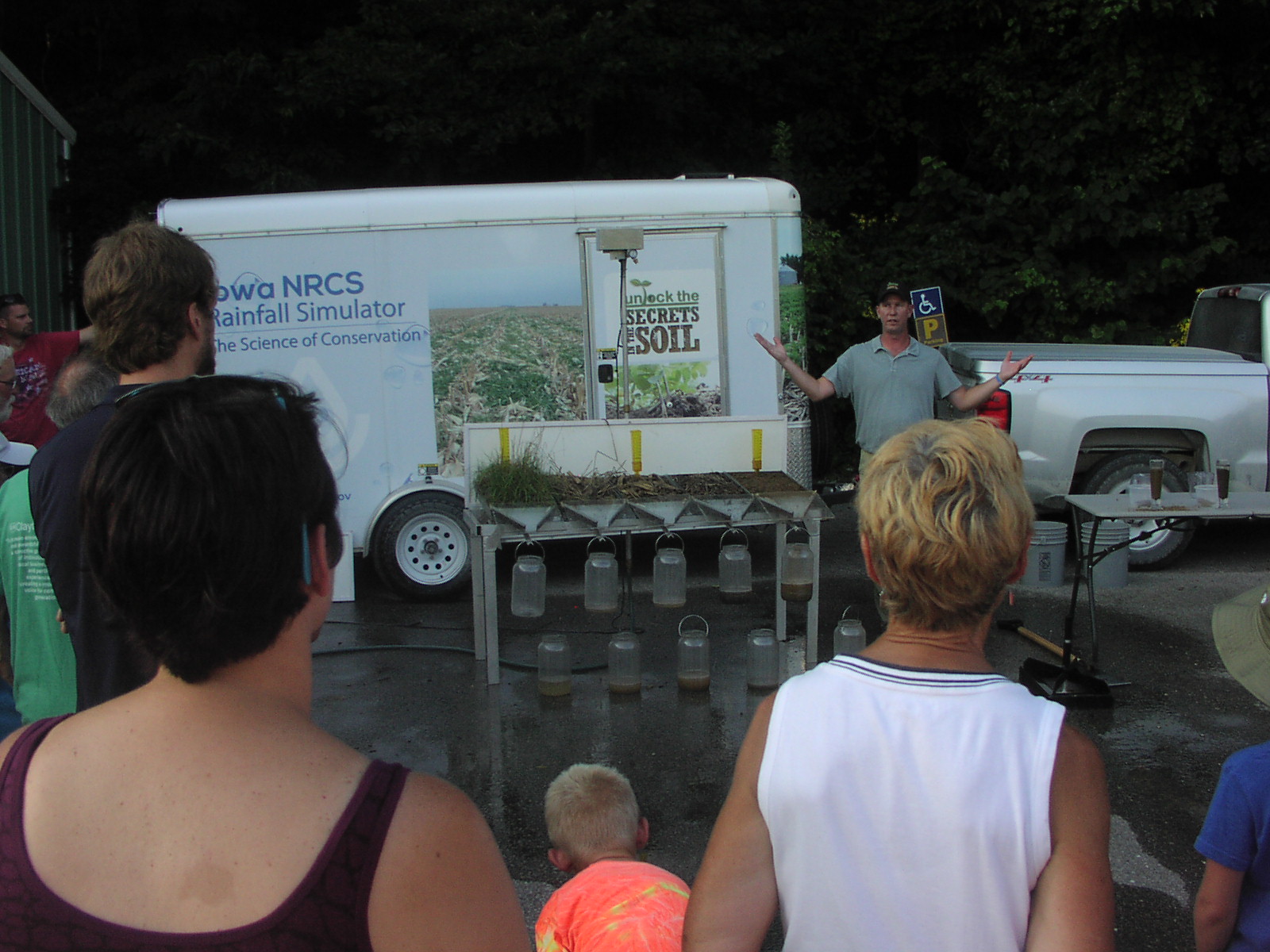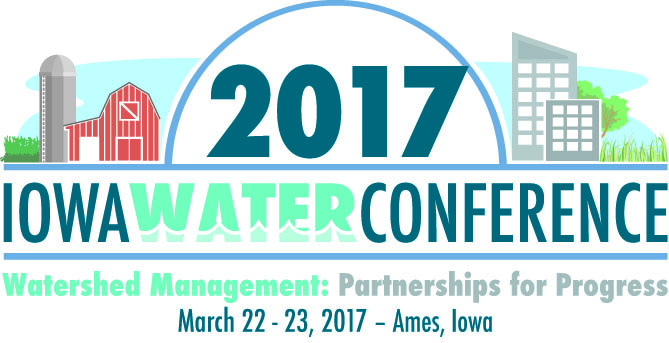Over September 9-13, our new ISU PhD student Tania Leung and I traveled to northwest Iowa to the Lakeside Laboratory. Our goals at Lakeside were twofold: to collect preliminary data on our Iowa Water Center funded project in order to plan our field campaign for summer 2017, and
to participate in the Phycological Research Consortium (PRC).
Farmers Connect Conservation to Water Quality at Big Spring
Elkader, IA. – On August 10th, fifty farmers from the Upper Roberts and Silver Creek Watersheds enjoyed an evening of family fun at the Big Spring Trout Hatchery along the Turkey River near Elkader. The Second Annual Landowner Appreciation Day allowed farmers and their families to follow the path of water that drains from their land to where it reemerges at Big Spring.
Continue readingIWConf17 presentation applications are due (really) soon
If you’ve been putting off submitting an application to present at the 2017 Iowa Water Conference, put it off no longer – applications are due Sunday night (Aug 14) at 11:59 p.m. The IWConf17 planning committee will review in the weeks following as the “first cut” for determining the 2017 conference agenda.
(It’s okay if you wait until Sunday to submit. It’s not procrastination. You’re busy. It’s prioritization.)
Wondering if you should submit an application? Do you answer yes to any of the following questions?
-Do you have a story to tell about watershed successes?
-Are you looking for partners for a current or new project?
-Do you have the latest tool in your water management field with proven results?
-Have you figured out a way to engage new sectors of populations in water-related activities or conversations?
From the call for applications:
The Elixir of Life: An Invitation
Guest blog by Jodi Enos-Berlage, Biology Professor at Luther College in Decorah, Iowa
Water—one of the simplest molecules on earth, is the basis for all life, and this requirement is non-negotiable. The great mystery then, is how we humans have allowed this sacred molecule to become the most polluted substance on earth, and what we should do to solve this problem.
Six years ago, an ISU Extension representative called me to ask if I would be interested in leading a water quality monitoring effort in an impaired waterhshed in Northeast Iowa. I was a scientist and an educator who grew up on a farm. I had read about the many water quality problems in Iowa. In fact, I lived in this impaired watershed, and knew my farm might be contributing to the problem. I said yes.
What began as project to collect water quality data evolved into something much bigger—sharing data and forming relationships with local farmers, using that data to secure funding for water quality improvement practices, developing a three-week, water-focused laboratory in my microbiology course, six years of water quality research involving over 15 undergraduate students, eight presentations and publications, and finally, an amazing collaboration with a dancer, a musician, and a cinematographer at Luther College that resulted in Body of Water. I now invite you to experience this unique work.
Body of Water is an original, unique performance that intermixes dance, music and video components. Art and science are intentionally interwoven to create an end product more powerful than the sum of its parts. The overall goal was to reveal the sacredness of this essential molecule and elixir of life. No one in our group was aware of a precedent for this type of performance, so it was a real experiment. While the videos, many of which I narrate, tell the story of the essentialness of water for life, its geographic connectivity, its chemistry and biology, and the major pollutants that impact both surface and groundwater, the dancers and musicians produce complementary and novel movements that provide the basis for emotional and human connection. We spent hours interviewing various stakeholders about water–this informed the performance, and some of their visual and audio clips are included. Local and state water issues, both agricultural and urban, are highlighted. The reverence that Native American populations have consistently and powerfully exhibited for this precious resource also inspired the work.
Notably, the purpose of the performance was not to take any particular position, e.g., a regulatory or voluntary approach, mainly because no matter where someone might stand on this spectrum, it has a divisive effect. Our goal was to create a performance that would unite, through an informational, and perhaps more importantly, emotional and spiritual experience. Based on the audience responses at the multiple sold out shows at Luther College, and at the subsequent Grinnell Summer Arts Festival, we are humbled by the outcome. The audience we attracted at Luther was one of the most diverse ever in terms of a performance, and included members of agricultural, urban, and conservation groups, scientists and artists, educators and students, and community members and leaders. It is our sincere hope that the performance at ISU will attract a similarly diverse audience.
We are incredibly excited to be partnering with a group of Ames High School students—the Bluestem Institute—for the pre-performance, as the creative work of our young people provides the greatest inspiration. These students will be presenting the beautiful products of their year-long research and service learning project focused on water. We have much to learn from them.
Ultimately, we acknowledge Body of Water as a prayer to return to a right relationship with the earth—recognizing that our own success is not dependent our abilities to control or dominate, but on our abilities to harmonize and see ourselves as a part. In this spirit, we are freely contributing our energies to spread this message. There is no charge for admission and we hope you will be inspired to attend.
Body of Water will be presented as a part of Art of Water 2016 on March 23 at CY Stephens Auditorium in Ames, Iowa
The Third [Business] Day of Christmas: Breakouts: Strategies for Social Engagement
On the third [business] day of Christmas, the Iowa Water Center gave to me…descriptions for the breakout session Strategies for Social Engagement.
The following presentations will take place at the Iowa Water Conference in Ames on the afternoon of Wednesday, March 23, 2016. Registration for the conference will open in January.
1000s of Acres: Adding Conservation Partners
Angie Carter, Department of Sociology, Anthropology, and Social Welfare at Augustana College in Rock Island, IL & Jean Eells, E Resources Group
Women farmland owners are an important part of watershed level conservation changes in Iowa. Learn from researchers and landowners about how PhotoVoice, a participatory research method, is being used in the Raccoon River watershed to engage this important demographic.
Water in Iowa: Voicing the Lexicon
Chad Žmolek, Mike Todd, Joe Brekke and Ames High School Bluestem Institute students
Students from the Bluestem Institute at Ames High School share insights gained from their journey across Iowa examining water quality issues in collaboration with Project Localize, an educational program that helps classrooms identify and promote sustainable economic, cultural and social progress in their communities. As part of the project, students created unique posters shining light on terms related to water quality. Following the presentation, the students will be available during the conference break to answer questions about their posters, which will be on display in the second floor lobby area.
Iowa farmers’ perspectives on actions toward nutrient reduction strategy goals
J. Gordon Arbuckle, Jr., Associate Professor/Extension Sociologist, Department of Sociology, Iowa State University
In spring 2014, 1,128 Iowa farmers were surveyed to measure their knowledge of the strategy, their attitudes and concerns toward it and its goals, and, importantly, their willingness to take action to help meet those goals. A regression analysis was conducted to evaluate factors that influence farmers’ willingness to take steps to support the strategy. The results of this analysis will be shared.
retaiN Iowa: Engaging Farmers in On-farm Nitrogen Testing
Jamie Benning, Water Quality Program Manager, Iowa State University Extension and Outreach & Clare Lindahl, Executive Director, Conservation Districts of Iowa
retaiN seeks to give farmers the tools and information they need to make the best conservation decisions on their land, starting by helping farmers test for, understand and take steps to retain their nitrogen. The retaiN project developed nitrate testing kits that facilitate farmer engagement in collecting on-farm nitrate concentration data. The retaiN kits were initially distributed in the summer and fall of 2015 through existing watershed projects and ISU Extension field specialists. retaiN is a collaboration between Conservation Districts of Iowa and Iowa State University Extension and Outreach and Iowa Learning Farms with support from the Iowa Department of Agriculture and Land Stewardship, Division of Soil Conservation and Water Quality.

